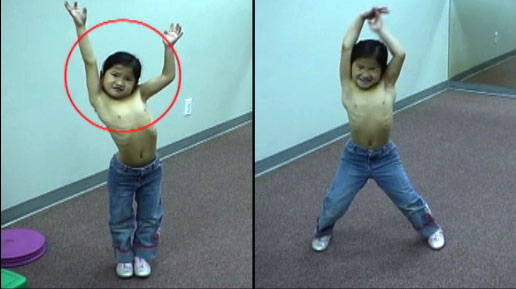It is accepted medical wisdom that peripheral nerve injuries have a reasonable potential for recovery. In spite of this, babies do not recover after a brachial plexus injury (BPI) as well as expected. Up to 75% percent of babies with BPI recover completely in the first three months. They had a very mild injury to start, similar to a bruise on the nerve. The remaining children, even those with mild injury, often have problems with growth of the arm and hand, bone and joint distortions, and decreased function. Many of these children show good enough regeneration of nerve on follow up EMG studies, but the function is not normal. There are two reasons these results. The bony distortions are caused by unbalanced muscle pull. The nerves that were undamaged have a normal strength, while the opposing muscles with damaged nerves are weak. The bones grow in response to the muscle pull and unbalance pull leads to unbalanced growth. Some of the secondary problems with shoulder growth have been diagnosed as early as 6 months of age.
Developmental apraxia is the cause of poor function in the presence of good enough nerve regeneration. Immediately after the injury, the arm is paralyzed and this lasts for months after birth. As the nerve gradually recovers, the baby uses only those muscle groups that recover first and ignores the ones that are not working. Their brains “wire” into the pattern of only using some of the muscles. With repeated use of this abnormal pattern, it becomes their habitual movement. This young girl’s abnormal arm lift is an early learned pattern that is automatic to her. Doing jumping jacks is a new skill that does not activate the habit. She is helped by momentum, but even so, she is actively elevating her shoulder, a skill that seems impossible when asked to lift her hand.
Fortunately, the child’s brain continues to actively grow and mature for at least 18+ years and all our brains can reorganize and learn new skill into old age. The challenge in the child with BPI is to recognize the role of habit by carefully watching for occasional use of the weaker muscle groups. In a child with hand involvement, just one pincer grasp is enough to train normal function. Physicians and therapists can test for reinnervation with simple, surface EMG biofeedback devices and then work out just what is needed to retain the child’s movement patterns.
The Great Ideas section of this site is a “work in progress” where I will post information about technologies and treatments that have been used for babies and children with BPI that I hope will be helpful. Talk to your physician and therapist to see if any of them would be appropriate for your child. I will also try to link to teaching schedules of courses for therapists to help spread the word about effective interventions. Help me in this project by writing in about approaches that have helped your child or patient. I am also very interested in more examples of Habit Hides Recovery in your child or patient.
